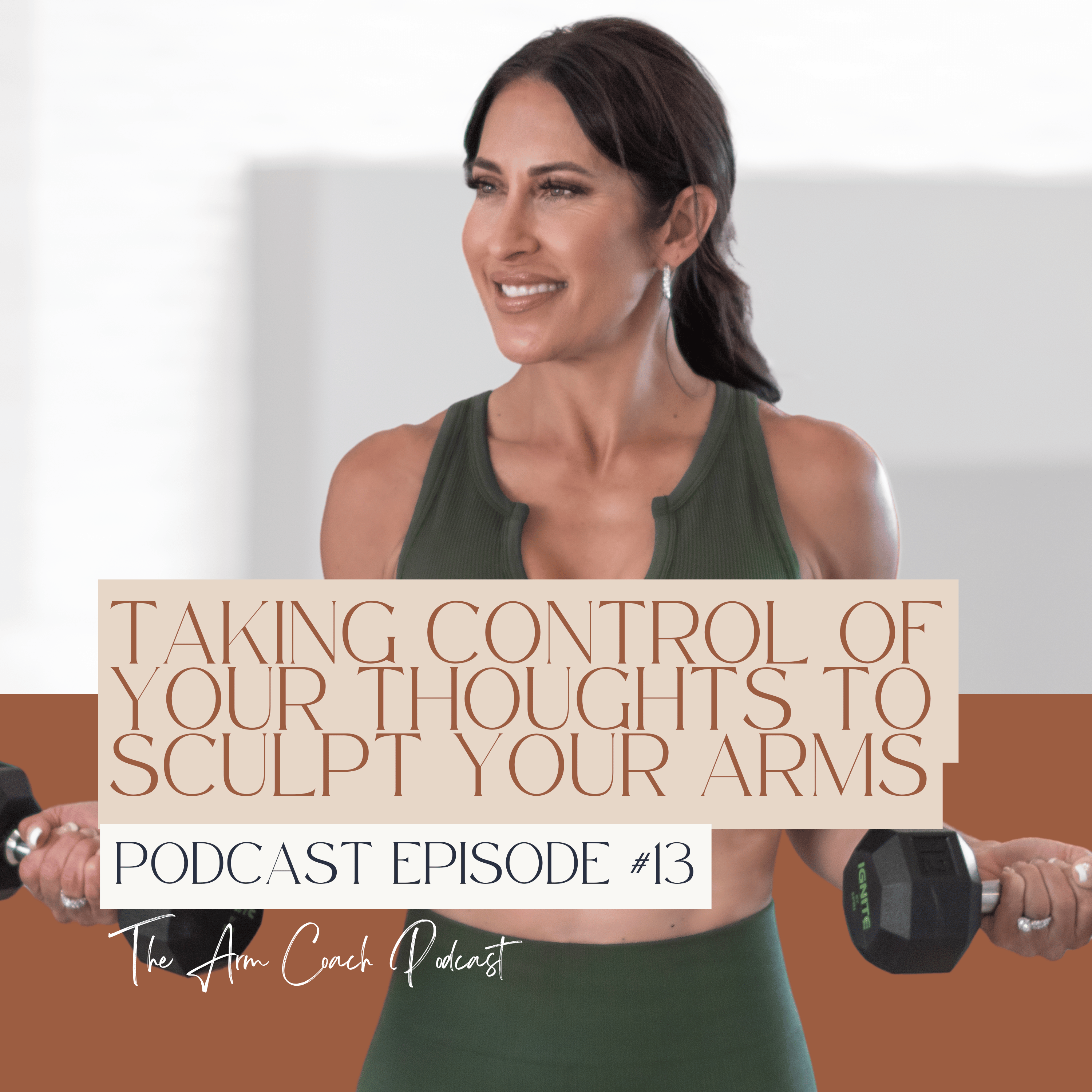Episode Transcript
Ladies, let’s get real—
motivation is great for
getting started, but it’s not
what’s going to carry you to
the finish line. In this
episode of The Arm Coach,
we’re diving deep into the
truth about motivation: why
it fades, what to do when it
does, and how to rely on
something far more
powerful.
Hey everyone! Welcome to
The Arm Coach podcast,
episode 43! This is your go-
to podcast for women ready
to sculpt, tone, and
transform—not just your
arms, but your mindset.
Because here’s the thing, this
journey isn’t just about
flexing biceps in the mirror
(although we love that too);
it’s about pushing past
limits, one step at a time,
and letting that growth
positively impact every
aspect of your life. I’m here
to be your coach, your
cheerleader, and maybe
sometimes your sassy wake-
up call. Let’s dive in!
[Segment One: Setting the
Stage]
Alright, today we’re talking
about something BIG. The
“M” word. No, not muscles
—although that’s always in
the mix. I’m talking about
motivation.
Right now, if you’re
catching this in real time, it’s
the start of a shiny new year.
That magical time when
you’re all “New Year, New
Me” and writing down
resolutions like you’re
signing a treaty with
yourself. It’s natural—you
feel hope, optimism, and a
sense that maybe this time,
things will be different.
But here’s the thing: What
happens when the calendar
flips to February? When the
champagne glow wears off,
and the motivation you
swore was unshakable starts
to fade? That’s where we’re
going today—deep into the
trenches of motivation. How
to spark it, sustain it, and
refresh it when it inevitably
wanes.
[Segment Two:
Understanding Motivation]
First things first: let’s break
motivation down. You might
think I’m here to “motivate”
you, right? Wrong.
Motivation is an inside job,
my friend.
Motivation is a feeling, a
spark that drives action. It’s
the energy behind why you
decide to lace up those
sneakers, grab those
dumbbells, or whip up a
protein smoothie instead of
inhaling that bag of chips.
It’s the voice that says, “I’m
doing this because I’m worth
it,” even when you’d rather
stay in bed. It’s personal, and
it’s fueled by one thing: your
thoughts.
Think about it—everything
you feel motivated to do
starts with a thought. When
you see someone rocking a
sleeveless top and think, “I
want that kind of
confidence,” or when you
imagine yourself lifting
heavier weights and think,
“I’m getting stronger every
day,” those thoughts ignite
the spark. That’s motivation.
It’s not me, it’s not your
trainer, and it’s definitely not
Karen from book club who
keeps bragging about her
Peloton. It’s YOU.
Now, I know what you’re
thinking: “If motivation
comes from me, why does it
disappear faster than I can
say ‘arm day’?” Oh, my
friend, let me break it down.
Habits. That’s why. Your
brain LOVES the old stuff—
it’s comfy, it’s easy, it’s safe.
Imagine this: You’re all fired
up to try a new workout.
You’ve got your leggings on,
playlist ready, and then...
boom. Your brain whispers,
“But wouldn’t it be nice to
just chill on the couch with a
little Netflix and snacks?”
That’s your lower brain
talking—the part that clings
to what you’ve always done,
what feels familiar.
And guess what? That’s not
sabotage—it’s just habit.
Picture it like a well-worn
path in the woods. Your
brain has walked that path a
thousand times, so when you
try to veer off and create a
new trail, it freaks out.
“Wait! Where are we going?
We don’t do this! Let’s head
back to what we know.”
Let’s add some real-life
scenarios here. Maybe
you’ve decided to start a
morning workout routine.
Day one, you’re pumped.
You’re up at 6 a.m., sneakers
laced, ready to crush it. Day
two? Your alarm goes off,
and your brain goes, “Oh,
come on, it’s cold. You can
totally start again
tomorrow.” Or how about
this one: You commit to
cutting out late-night snacks,
but as soon as you sit down
to watch your favorite show,
the pantry starts calling your
name like a long-lost lover.
That’s not failure—it’s just
your old habits waving their
hand in the air, saying, “Hey,
remember us?”
But here’s the thing: You
don’t have to listen to that
voice. You’re the boss here.
That lower brain might be
loud, but you’ve got the
power to override it. Think
of it like turning the radio
dial to tune out static. When
your brain says, “Skip the
workout,” you can respond,
“Thanks for your input, but
I’ve got goals, and this
workout isn’t optional.”
And listen, trust me, every
time you do that—every
time you choose the new
path—you’re rewiring your
brain. You’re creating new
habits. And those habits?
They become the foundation
of your success.
So, the next time you hear
that little voice whisper,
“Let’s just skip today,”
remind yourself: It’s not
sabotage. It’s just a habit.
And habits can be changed.
[Segment Three:
Refreshing Your Why]
So, how do you keep
motivation alive? It’s simple:
know your why, and revisit
it often.
Your why is your secret
weapon. It’s not just some
fluffy concept—it’s the
driving force that gets you
off the couch, into your
sneakers, and into action.
And let me be real with you:
if your why is flimsy, your
motivation will crumble at
the first sign of resistance.
Here’s the deal: your why
can’t be something
superficial like, “I want
toned arms so Karen at book
club will stop showing me
up.” Sure, that might fire you
up for a week, but when the
alarm goes off at 6 a.m. or
the brownies at the bake sale
start whispering your name,
Karen isn’t going to be
enough to keep you on track.
Instead, think deeper. Why
do you really want this?
Maybe it’s about feeling
stronger for your grandkids.
Imagine picking them up,
playing with them, and not
having to say, “Grandma
needs to sit this one out.” Or
maybe it’s proving to
yourself that age is just a
number and you’re capable
of more than you ever
imagined. Or how about this
one—standing tall in the
mirror, looking at your
reflection, and saying with
pride, “I did this for me. No
one else, just me.”
The key here is that your
why needs to be personal,
powerful, and deeply rooted
in what matters to you. It
needs to light a fire inside
you, even on the hard days.
And trust me, there will be
hard days.
Now, here’s the next step:
write it down. I mean it—
grab a pen and paper and
write it down. Not on your
phone, not in a random app
you’ll forget about. There’s
something magical about
putting pen to paper. It
makes your why feel real,
tangible, and unforgettable.
Let me give you an example.
Say your why is, “I want to
feel strong and confident.”
That’s a great start, but let’s
take it further. Ask yourself:
Why do I want to feel strong
and confident? Maybe it’s
because you’ve spent years
doubting yourself, and
you’re ready to rewrite that
narrative. Maybe it’s
because you want to feel
empowered, like you’re in
control of your life and your
body. Maybe it’s because
you’re tired of hiding in
oversized cardigans at
summer BBQs, and you’re
ready to own every
sleeveless outfit in your
closet.
Here’s another example:
Let’s say your why is, “I
want to lose weight.” Okay,
but why? Maybe it’s because
you want to avoid health
issues that run in your
family. Maybe it’s because
you want to travel, hike, or
play with your grandkids
without feeling exhausted.
Or maybe it’s because you
want to wake up every
morning with energy and
confidence, ready to take on
the day.
Your why should make you
feel something. It should tug
at your heartstrings, stir up a
little emotion, and remind
you of what’s at stake.
But here’s where people
mess up: they forget about
their why. Life gets busy,
motivation fades, and
suddenly that powerful why
ends up shoved into the back
of your mind like an old pair
of shoes you haven’t worn in
years. Don’t let that happen.
Keep your why front and
center.
Try this:
• Create a vision board.
Fill it with images, words,
and quotes that remind
you of your why. Hang it
somewhere you’ll see it
every day—your
bathroom mirror, your
fridge, your workout
space.
• Set daily reminders.
Program your phone to
send you motivational
notifications. For example:
“Remember why you
started. You’re worth
this!”
• Make it visible. Write
your why on a sticky note
and stick it on your
computer screen, your
nightstand, or your coffee
maker. Anywhere you’ll
see it often.
• Talk about it. Share your
why with a trusted friend,
family member, or even
your workout buddy.
Saying it out loud makes it
more real and keeps you
accountable.
And don’t be afraid to
evolve your why. Life
changes, and so do our
motivations. What drives
you today might not be the
same thing that drives you
six months from now—and
that’s okay. Check in with
yourself regularly. Does
your why still light you up?
Does it still feel meaningful?
If not, dig deeper and refine
it.
Here’s the truth: your why is
your anchor. On the tough
days, when motivation feels
like it’s packed its bags and
left town, your why is what
pulls you back. It’s what
keeps you grounded and
reminds you of the bigger
picture.
So, take a moment right
now. Grab a pen and write it
down:
• What do you want?
• Why do you want it?
• How will achieving this
make you feel?
Then, put that paper
somewhere you’ll see it
every single day. Because
here’s the thing, my friend:
motivation comes and goes,
but a powerful why? That’s
the fuel that keeps you
going. Let’s keep that fire
burning.
[Segment Four:
Overcoming the
Motivation Slump]
Let’s address the elephant in
the room: motivation fades.
It’s a fact of life, and while
it’s completely natural, it’s
also preventable if you’re
intentional about how you
handle it. Motivation might
get you started, but it’s not
always going to stick around
like an enthusiastic
cheerleader.
Motivation alone won’t
carry you. It’s like a match
—it can start the fire, but it
won’t keep the fire burning.
At some point, discipline has
to take over.
So, what is discipline,
really? It’s the quiet,
unglamorous hero of
progress. It’s the voice that
says, “I don’t feel like doing
this, but I’m going to do it
anyway because my goals
are worth it.” Discipline is
showing up for yourself,
even on the days when you’d
rather stay in bed, skip the
workout, or indulge in an old
habit.
Picture this: It’s a rainy
Monday morning, and your
alarm goes off for your
workout. Motivation?
Nowhere to be found. It’s
snoozing under the covers
while your brain tempts you
with excuses. “You’re tired,”
it whispers. “One day won’t
hurt. Just rest.” But
discipline? Discipline rolls
its eyes, pulls you out of
bed, and says, “We’re doing
this, rain or shine, because
skipping today makes it
easier to skip tomorrow.”
Here’s the thing: Discipline
isn’t always sexy, and it
definitely doesn’t come with
instant gratification. But it
builds something far more
powerful—consistency. And
consistency is what creates
results. It’s what transforms
“I’m trying” into “I did it.”
Think about some of the
most rewarding moments in
your life. Chances are, they
weren’t fueled by fleeting
motivation—they were built
on the back of discipline.
Maybe it was finishing a
tough project at work,
running that 5K you didn’t
think you could, or finally
hitting a health milestone
after months of effort. Those
wins? They weren’t handed
to you. You earned them by
showing up, day after day,
even when it wasn’t easy.
Discipline in Action:
Practical Tips
1.Create a Non-Negotiable
Routine
Decide ahead of time what
you’re going to do, and
make it non-negotiable.
For example: “I work out
every Monday,
Wednesday, and Friday at
7 a.m.” It’s not up for
debate, it’s just what you
do—like brushing your
teeth or drinking your
morning coffee.
2.Set Micro-Goals
Big goals are exciting, but
they can also be
overwhelming. Break
them down into bite-sized
pieces. Instead of “I want
toned arms by summer,”
focus on, “I’m going to
complete 3 upper-body
workouts this week.”
Small wins build
momentum.
3.Remove the Decision
Fatigue
Don’t leave room for
excuses. Lay out your
workout clothes the night
before, prep your meals
ahead of time, or schedule
your workout like a
doctor’s appointment.
When everything’s ready
to go, it’s easier to follow
through.
4.Use the Two-Minute
Rule
Feeling zero motivation?
Commit to starting for just
two minutes. Tell yourself,
“I’ll put on my sneakers
and stretch for two
minutes, and if I still don’t
feel like it, I’ll stop.” Nine
times out of ten, you’ll
keep going. The hardest
part is starting.
5.Be Kind but Firm with
Yourself
This one’s huge.
Discipline isn’t about
being a drill sergeant—it’s
about being your own best
coach. If you miss a day
or slip up, don’t spiral into
guilt or self-criticism.
Acknowledge it, learn
from it, and get back on
track.
The Magic of Discipline:
Turning It Into a Habit
Here’s the cool thing about
discipline: the more you
practice it, the less effort it
requires. What starts as a
deliberate choice—forcing
yourself to show up—
eventually becomes a habit.
And when it becomes a
habit, it feels automatic.
Think of it like building a
muscle. At first, it’s hard, it’s
uncomfortable, and you
might feel like giving up.
But the more you train it, the
stronger it gets. Before you
know it, discipline becomes
second nature.
And the best part? Discipline
doesn’t just help you crush
your arm and fitness goals—
it spills over into every area
of your life. When you learn
to show up for yourself in
the gym or in the kitchen,
you start showing up for
yourself everywhere else.
You build confidence. You
trust yourself to follow
through. You become
unstoppable.
So, yes, motivation will
fade. That’s inevitable. But
discipline? That’s the steady
drumbeat that keeps you
moving forward. Motivation
might light the spark, but
discipline keeps the fire
burning.
And when you combine the
two—motivation to start and
discipline to stay the course?
That’s when the magic
happens. That’s when goals
turn into reality. So, let’s
make a pact: On the days
when motivation is nowhere
to be found, we lean on
discipline. Deal?
[Segment Five: Making the
Journey Enjoyable]
Ladies, let’s not glamorize
the grind. Yes, growth
happens outside your
comfort zone, but that
doesn’t mean the journey
has to be miserable.
Ask yourself, how can you
make your toned arm
journey feel good even while
you're working on it, versus
that old way of thinking, oh,
I'll reward myself and I'll
feel good once I'm at my
goal. To be and stay
motivated, you can't be
forcing yourself to do
something painful or really
unpleasant the whole way
there. Yes, when you're
doing something new, there's
going to be discomfort,
right? That's why they call
reaching for goals moving
out of your comfort zone.
But it can't feel awful and
painful the whole way
through.
So ask yourself: How can
you make the process
enjoyable? Maybe it’s
cranking up your favorite
playlist while you work
those triceps. Maybe it’s
celebrating small wins—like
when you finally move up to
heavier weights. Or maybe
it’s as simple as knowing
you’re taking time for YOU.
Here’s my favorite trick:
Treat your goals like a
dance, not a death march.
Find the rhythm that works
for you, and enjoy the steps
along the way.
[Segment Six: Your Action
Plan]
Alright, here’s your
homework. I want you to
grab a notebook and write
down:
1.What you want. Be
specific. Not just “toned
arms,” but “I want to feel
strong enough to rock
sleeveless dresses without
a second thought.”
2.Why you want it. Dig
deep. Find the emotional
core of your goal.
3.How you’ll keep your
why front and center.
Will it be a vision board?
A daily mantra? A
reminder on your mirror?
You decide.
And remember, your why
has to light you up. If it
doesn’t, it’s time to revise or
replace it.
[Outro: Final Words from
The Arm Coach]
Here’s the bottom line:
Motivation is your personal
fire, and you’re the one
holding the matches. Keep it
lit by revisiting your why,
making the journey fun, and
refusing to let old habits pull
you back.
You’ve got this. Whether it’s
January 1st or July 23rd,
every day is a chance for a
fresh start. So, let’s get out
there and own it.
Thanks for tuning in to The
Arm Coach! If today’s
episode gave you a boost,
share it with a friend—or
heck, your whole book club.
And don’t forget to drop me
an email with your goals and
motivation—I love hearing
from you. Until next time,
keep lifting, keep growing,
and keep being your fierce,
fabulous self.


